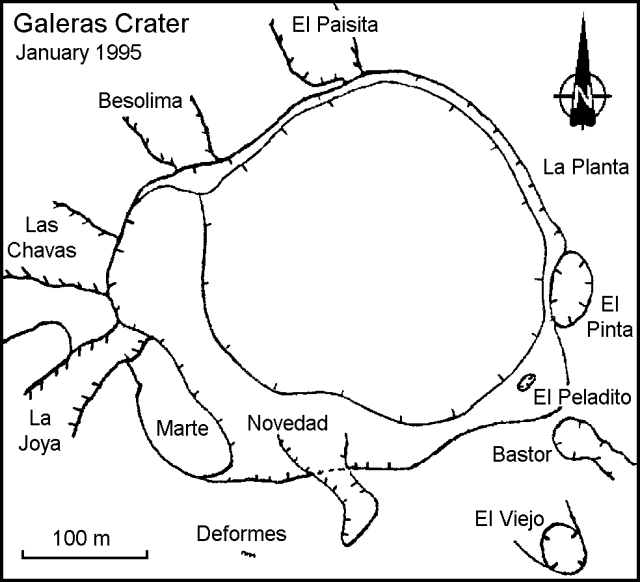Report on Galeras (Colombia) — February 1995
Bulletin of the Global Volcanism Network, vol. 20, no. 2 (February 1995)
Managing Editor: Richard Wunderman.
Galeras (Colombia) Continued fumarolic activity and low SO2 values; new type of seismicity
Please cite this report as:
Global Volcanism Program, 1995. Report on Galeras (Colombia) (Wunderman, R., ed.). Bulletin of the Global Volcanism Network, 20:2. Smithsonian Institution. https://doi.org/10.5479/si.GVP.BGVN199502-351080
Galeras
Colombia
1.22°N, 77.37°W; summit elev. 4276 m
All times are local (unless otherwise noted)
Activity during January and February consisted of slow gas release, decreasing the chances of an eruption in the near future. Overflights on 6 and 9 January revealed no changes in the fumarolic activity. On 23 January a visual inspection of the active cone from the police station revealed increased fumarolic activity in the W sector. In several visits to the summit, the principal points of gas emission were La Joya, Las Deformes, Las Chavas, and El Paisita fumarolic areas, and low-pressure zones on the interior of the main crater and the inside W crater wall (figure 72); fumarolic columns rose <30 m. Temperature measurements at Las Deformes and La Joya fumaroles (average 130°C) showed a small decrease compared to 21 July 1994.
SO2 measurements obtained by COSPEC increased compared to December (2 remained stable during February (~200 t/d), and deformation measurements showed no variations.
A total of 89 screw-type seismic events were recorded between 20 October 1994 and 9 January. These types of signals, associated with pressure in the system, preceded five of the six eruptions between June 1992 and July 1993. Long-period events were recorded after 9 January. A swarm of "butterfly" events (a hybrid long-period, high-frequency event) on 20 January was the first since July 1994; a peak of 210 events was recorded on the 21st. The number of high-frequency events was very low in early 1995, but increased slightly after 23 January. These signals, which have a similar wave form to long-period events, were located principally in the W sector of the active crater at depths of <4 km.
Shallow high-frequency seismicity in February was concentrated near the crater. There was also sporadic fracturing activity from the W part of the crater (small magnitudes with depths <6 km) and from a N source (M <1.9 and depths of 5-7 km). "Butterfly" events were observed through mid-Feb with an average of 50 events/day before decreasing to 15 events/day toward the end of the month. These events were concentrated near the active cone, at depths <1 km. Few long-period events occurred during the month, but after 26 February a new type of high-frequency signal (called "Pseudo-Screw") began with dominant peaks of 8-10 Hz.
Geological Summary. Galeras, a stratovolcano with a large breached caldera located immediately west of the city of Pasto, is one of Colombia's most frequently active volcanoes. The dominantly andesitic complex has been active for more than 1 million years, and two major caldera collapse eruptions took place during the late Pleistocene. Long-term extensive hydrothermal alteration has contributed to large-scale edifice collapse on at least three occasions, producing debris avalanches that swept to the west and left a large open caldera inside which the modern cone has been constructed. Major explosive eruptions since the mid-Holocene have produced widespread tephra deposits and pyroclastic flows that swept all but the southern flanks. A central cone slightly lower than the caldera rim has been the site of numerous small-to-moderate eruptions since the time of the Spanish conquistadors.
Information Contacts: INGEOMINAS, Pasto.


